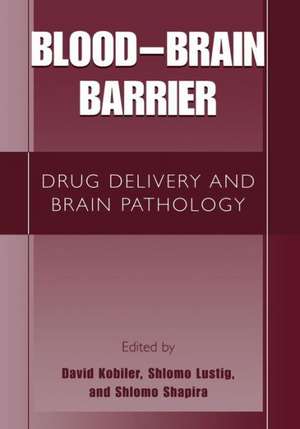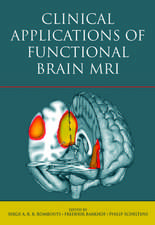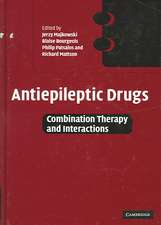Blood-Brain Barrier: Drug Delivery and Brain Pathology
Editat de David Kobiler, Shlomo Lustig, Shlomo Shapiraen Limba Engleză Paperback – 5 noi 2012
Preț: 382.99 lei
Preț vechi: 403.15 lei
-5% Nou
Puncte Express: 574
Preț estimativ în valută:
73.29€ • 76.24$ • 60.51£
73.29€ • 76.24$ • 60.51£
Carte tipărită la comandă
Livrare economică 15-29 aprilie
Preluare comenzi: 021 569.72.76
Specificații
ISBN-13: 9781461351412
ISBN-10: 1461351413
Pagini: 448
Ilustrații: XII, 434 p.
Dimensiuni: 178 x 254 x 24 mm
Greutate: 0.77 kg
Ediția:2001
Editura: Springer Us
Colecția Springer
Locul publicării:New York, NY, United States
ISBN-10: 1461351413
Pagini: 448
Ilustrații: XII, 434 p.
Dimensiuni: 178 x 254 x 24 mm
Greutate: 0.77 kg
Ediția:2001
Editura: Springer Us
Colecția Springer
Locul publicării:New York, NY, United States
Public țintă
ResearchCuprins
1. Overview of the Structure and Function of the Blood-Brain Barrier in vivo.- 2. Expression and Modulation of Blood-Brain Monocarboxylate Transporters.- 3. Neuroprotective and Detoxifying Mechanisms at the Blood-Brain Interfaces.- 4. Measurement and Prediction of Blood-Brain Barrier Permeability: In vivo, in silico and in vitro approaches.- 5. Recent Advances in the Development of Cell Culture Models for the Blood-Brain and Blood-CSF-Barrier.- 6. Gene Expression Changes and Progression to a BBB Phenotype in a Dynamic Model of the BBB.- 7. Novel Endothelial-Mediated Responses Associated with Micro-Circulation and BBB function.- 8. Modulators of Blood-Brain Barrier (BBB) Permeability: In Vitro and In Vivo Drug Transport to the Brain.- 9. Controlled Modulation of the Blood-Brain and Blood-Tumor Barrier Using Novel Lipid Mimetic Compounds.- 10. Carbon Dioxide Gas as an Angiographic Contrast Agent in the Cerebral Circulation.- 11. Diffusion MRI and Q-Space Diffusion MRI: From Cerebral Ischemia to Multiple Sclerosis and Beyond.- 12. Brain Iron Uptake and Transport in Animal Model of Iron Deficiency, Tardive Dyskinesia and Neurodegenerative Diseases.- 13. Stress, Pyridostigmine and the Blood-Brain Barrier.- 14. Transcytosis and Signalling of Pneumococci at the Blood-Brain Barrier.- 15. Entry of Viruses into the Central Nervous System.- 16. An Animal Model for the Study of BBB Modulators.- 17. Physiological Pathways Responsible for the Breakdown of the Blood-Brain Barrier During Viral Encephalitis.- 18. Gene Transfer to the Salivary Glands: Application in Gene Therapy.- 19. The Effect of Hyperosmotic Blood-Brain Barrier Disruption on Experimental Autoimmune Encephalomyelitis.- 20. Direct In Vivo Evidence for ?4-Integrin Mediated Interaction of Encephalitogenic T Cells withEndothelial VCAM-1 in the Spinal Cord White Matter Using Intravital Fluorescence Videomicroscopy.- 21. The Blood-Brain Barrier in Immune Mediated Diseases of the Central Nervous System.- 22. Strategies for Increasing Drug Delivery to the Brain: Lessons Derived from Treatment of Brain Tumors.- 23. Intraarterial Therapy With or Without Radiation Therapy for Patients with Brain Tumors.- 24. Optimizing Drugs for Brain Action.- 25. The Role of Plasma Protein Binding in Drug Delivery to Brain.- 26. Issues Related to Intranasal Delivery of Neuropeptides to Temporal Lobe Targets.- 27. Synthesis of Poly(Carboxyphenoxypropane-Sebacic Anhydride) for the Delivery of Drugs to the Brain.- 28. Intranasal Delivery of Bioactive Peptides or Peptide Analogues Enhances Spatial Memory and Protects Against Cholinergic Deficits.- 29. Role of Inflammation in Stroke: Benefits or Harm?.- 30. Variations in Neuropathology and Pathophysiology Over Time and Among Areas in a Rat Model of Focal Areas in a Rat Model of Focal Cerebral Ischemia.- 31. Impairment and Pharmacological Protection of the Blood-Brain Barrier After Head Trauma.- 32. Pathophysiology of the Blood-Spinal Cord Barrier in Spinal Cord Injury.














